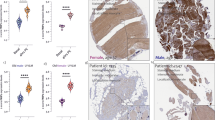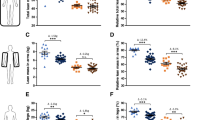Abstract
Background and aims: Aging is associated with significant losses of skeletal muscle mass and function. Numerous biochemical molecules have been implicated in the development of these age-related changes, however evidence from human models is sparse. Assessment of transcript expression is useful as it requires minimal tissue and may potentially be used in clinical trials. This study aimed to compare mRNA expression of proteolytic genes in skeletal muscle of young (18–35 yrs) and older (55–75 yrs) men. Methods: Muscle tissue was obtained from young (n=14, 21.35±01.03 yrs) and older (n=13, 63.85±1.83 yrs) men using percutaneous biopsy, and transcript expression was quantified using real-time polymerase chain reaction. Lower limb muscle mass was assessed using DEXA while concentric peak torque (PT) and power were assessed via isokinetic dynamometer. When age-related differences in mRNA expression were observed, Pearson correlation coefficients were obtained to examine the relationship of transcripts to muscle mass and function. Results: Older muscle contained significantly more transcript for Forkhead Box O 1 (FoxO1, p=0.001), Inhibitor of DNA binding 1 (ID1, p=0.009), and Inhibitor of DNA Binding 3 (ID3, p=0.043) than young muscle. FoxO1 was significantly correlated with lean mass (R=−0.44, p=0.023) and PT (R=−0.40, p=0.046) while ID3 was significantly correlated with PT (R=−0.58, p=0.001) and power (R=−0.65, p<0.001). Moreover, ID1 was significantly correlated with all assessed measures of muscle function - mass (R=−0.39, p=0.046), PT (R=−0.53, p=0.005), and power (R=−0.520, p=0.005). Conclusion: These data suggest that FoxO1, ID1, and ID3 are potentially useful as clinical biomarkers of age-related muscle atrophy and dysfunction.
Similar content being viewed by others
References
Newman AB, Kupelian V, Visser M et al. Strength, but not muscle mass, is associated with mortality in the health, aging and body composition study cohort. J Gerontol A Biol Sci Med Sci 2006; 61: 72–7.
Visser M, Goodpaster BH, Kritchevsky SB et al. Muscle mass, muscle strength, and muscle fat infiltration as predictors of incident mobility limitations in well-functioning older persons. J Gerontol A Biol Sci Med Sci 2005; 60: 324–33.
Federal Interagency Forum on Aging-Related Statistics. Statistical Data of Older Americans [www.agingstats.gov].
de Palma L, Marinelli M, Pavan M, Orazi A. Ubiquitin ligases MuRF1 and MAFbx in human skeletal muscle atrophy. Joint Bone Spine 2008; 75: 53–7.
Cao PR, Kim HJ, Lecker SH. Ubiquitin-protein ligases in muscle wasting. Int J Biochem Cell Biol 2005; 37: 2088–97.
Attaix D, Ventadour S, Codran A, Bechet D, Taillandier D, Combaret L. The ubiquitin-proteasome system and skeletal muscle wasting. Essays Biochem 2005; 41: 173–86.
Huang J, Forsberg NE. Role of calpain in skeletal-muscle protein degradation. Proc Natl Acad Sci USA 1998; 95: 12100–5.
Costelli P, Reffo P, Penna F, Autelli R, Bonelli G, Baccino FM. Ca(2+)-dependent proteolysis in muscle wasting. Int J Biochem Cell Biol 2005; 37: 2134–46.
Dargelos E, Brule C, Combaret L et al. Involvement of the calcium- dependent proteolytic system in skeletal muscle aging. Exp Gerontol 2007; 42: 1088–98.
Gilson H, Schakman O, Combaret L et al. Myostatin gene deletion prevents glucocorticoid-induced muscle atrophy. Endocrinology 2007; 148: 452–60.
Baumann AP, Ibebunjo C, Grasser WA, Paralkar VM. Myostatin expression in age and denervation-induced skeletal muscle atrophy. J Musculoskelet Neuronal Interact 2003; 3: 8–16.
McCroskery S, Thomas M, Maxwell L, Sharma M, Kambadur R. Myostatin negatively regulates satellite cell activation and self-renewal. J Cell Biol 2003; 162: 1135–47.
Alway SE, Degens H, Krishnamurthy G, Smith CA. Potential role for Id myogenic repressors in apoptosis and attenuation of hypertrophy in muscles of aged rats. Am J Physiol Cell Physiol 2002; 283: C66–76.
Alway SE, Degens H, Lowe DA, Krishnamurthy G. Increased myogenic repressor Id mRNA and protein levels in hindlimb muscles of aged rats. Am J Physiol Regul Integr Comp Physiol 2002; 282: R411–22.
Sun L, Trausch-Azar JS, Muglia LJ, Schwartz AL. Glucocorticoids differentially regulate degradation of MyoD and Id1 by N-terminal ubiquitination to promote muscle protein catabolism. Proc Natl Acad Sci USA 2008; 105: 3339–44.
Leger B, Derave W, De Bock K, Hespel P, Russell AP. Human sarcopenia reveals an increase in SOCS-3 and myostatin and a reduced efficiency of akt phosphorylation. Rejuvenation Res 2008; 11: 163–75B.
Williamson DL, Raue U, Slivka DR, Trappe S. Resistance exercise, skeletal muscle FOXO3A, and 85-year-old women. J Gerontol A Biol Sci Med Sci 2010; 65: 335–43.
Whitman SA, Wacker MJ, Richmond SR, Godard MP. Contributions of the ubiquitin-proteasome pathway and apoptosis to human skeletal muscle wasting with age. Pflugers Arch 2005; 450: 437–46.
Raue U, Slivka D, Jemiolo B, Hollon C, Trappe S. Proteolytic gene expression differs at rest and after resistance exercise between young and old women. J Gerontol A Biol Sci Med Sci 2007; 62: 1407–12.
Giresi PG, Stevenson EJ, Theilhaber J et al. Identification of a molecular signature of sarcopenia. Physiol Genomics 2005; 21: 253–63.
Buford TW, Cooke MB, Manini TM, Leeuwenburgh C, Willoughby DS. Effects of age and sedentary lifestyle on skeletal muscle NF-{kappa}B signaling in men. J Gerontol A Biol Sci Med Sci 2010; 65: 532–7.
Buford TW, Cooke MB, Shelmadine BD, Hudson GM, Redd L, Willoughby DS. Effects of eccentric treadmill exercise on inflammatory gene expression in human skeletal muscle. Appl Physiol Nutr Metab 2009; 34: 745–53.
Buford TW, Cooke MB, Willoughby DS. Resistance exercise-induced changes of inflammatory gene expression within human skeletal muscle. Eur J Appl Physiol 2009; 107: 463–71.
Livak KJ, Schmittgen TD. Analysis of relative gene expression data using real-time quantitative PCR and the 2(-delta delta C(T)) method. Methods 2001; 25: 402–8.
Sandri M, Sandri C, Gilbert A et al. FoxO transcription factors induce the atrophy-related ubiquitin ligase atrogin-1 and cause skeletal muscle atrophy. Cell 2004; 117: 399–412.
Zhao J, Brault JJ, Schild A et al. FoxO3 coordinately activates protein degradation by the autophagic/lysosomal and proteasomal pathways in atrophying muscle cells. Cell Metab 2007; 6: 472–83.
Zhao J, Brault JJ, Schild A, Goldberg AL. Coordinate activation of autophagy and the proteasome pathway by FoxO transcription factor. Autophagy 2008; 4: 378–80.
Allen DL, Unterman TG. Regulation of myostatin expression and myoblast differentiation by FoxO and SMAD transcription factors. Am J Physiol Cell Physiol 2007; 292: C188–99.
Attaix D, Baracos VE. MAFbx/Atrogin-1 expression is a poor index of muscle proteolysis. Curr Opin Clin Nutr Metab Care 2010; 13: 223–4.
Cai D, Frantz JD, Tawa NE Jr et al. IKKbeta/NF-kappaB activation causes severe muscle wasting in mice. Cell 2004; 119: 285–98.
Mourkioti F, Kratsios P, Luedde T et al. Targeted ablation of IKK2 improves skeletal muscle strength, maintains mass, and promotes regeneration. J Clin Invest 2006; 116: 2945–54.
Navarro M, Valentinis B, Belletti B, Romano G, Reiss K, Baserga R. Regulation of Id2 gene expression by the type 1 IGF receptor and the insulin receptor substrate-1. Endocrinology 2001; 142: 5149–57.
Kumar D, Shadrach JL, Wagers AJ, Lassar AB. Id3 is a direct transcriptional target of Pax7 in quiescent satellite cells. Mol Biol Cell 2009; 20: 3170–7.
Author information
Authors and Affiliations
Corresponding author
Rights and permissions
About this article
Cite this article
Buford, T.W., Cooke, M.B., Shelmadine, B.D. et al. Differential gene expression of FoxO1, ID1, and ID3 between young and older men and associations with muscle mass and function. Aging Clin Exp Res 23, 170–174 (2011). https://doi.org/10.1007/BF03324957
Received:
Accepted:
Published:
Issue Date:
DOI: https://doi.org/10.1007/BF03324957




